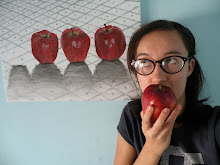I usually do look outside windows. Even on subway rides, when usually the most interesting thing to look at is the scratchings on the walls and the graffiti on the advertisements. Well, I don't know. Manhattan subway rides usually do give some form of entertainment. Musicians, schizo people.....
Actually, there's so much art in the subway stations. Its almost like visiting different galleries while underground; that is, if you change up your route sometimes.
Some of them move like animations when the train rides past the stations, and some are so huge, they look like installations. There are the really old mosaics, from the 1800s, and the shiny, coppery new ones.
Here's a good site to get lost underground in:
ooh pretty.


